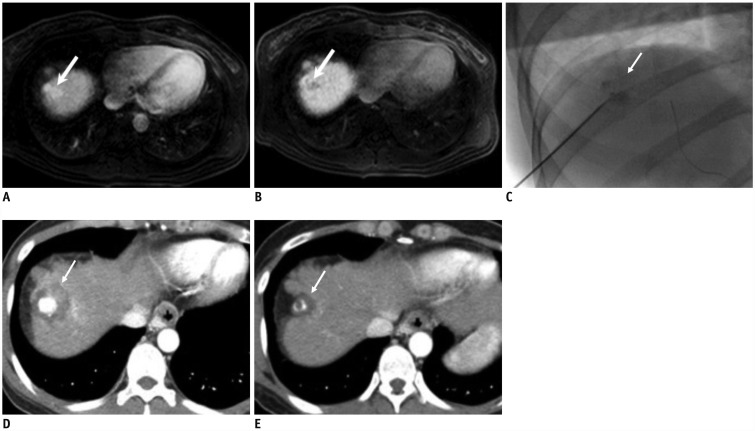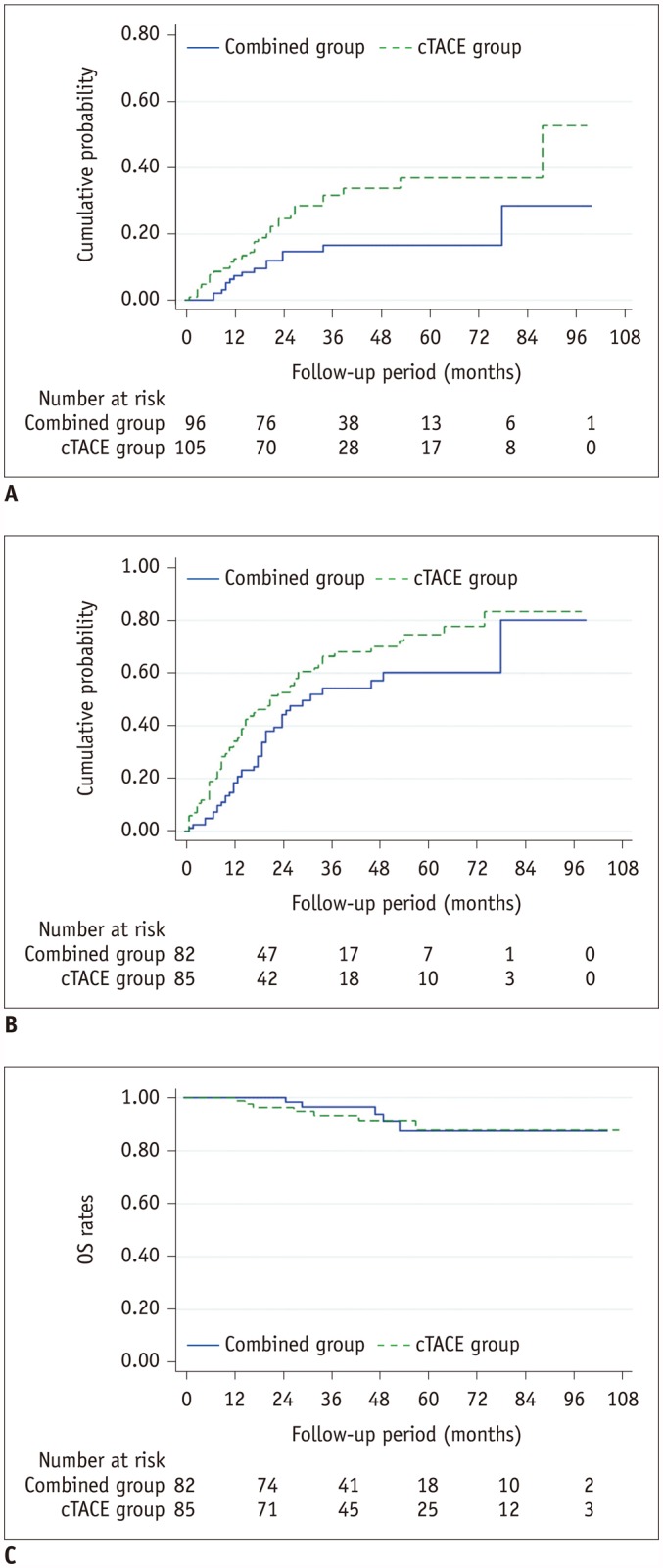Korean J Radiol.
2018 Dec;19(6):1130-1139. 10.3348/kjr.2018.19.6.1130.
Comparison of Combined Therapy Using Conventional Chemoembolization and Radiofrequency Ablation Versus Conventional Chemoembolization for Ultrasound-Invisible Early-Stage Hepatocellular Carcinoma (Barcelona Clinic Liver Cancer Stage 0 or A)
- Affiliations
-
- 1Division of Vascular and Interventional Radiology, Department of Radiology, Seoul National University Bundang Hospital, Seongnam 13620, Korea. yooncj1@gmail.com
- 2Division of Internal Medicines, Seoul National University Bundang Hospital, Seongnam 13620, Korea.
- KMID: 2424852
- DOI: http://doi.org/10.3348/kjr.2018.19.6.1130
Abstract
OBJECTIVE
To compare the therapeutic efficacy between conventional transarterial chemoembolization (cTACE) and combined therapy using cTACE and radiofrequency ablation (RFA) in ultrasound (US)-invisible early stage hepatocellular carcinoma (HCC).
MATERIALS AND METHODS
From January 2008 to June 2016, 167 patients with US-invisible early stage HCCs were treated with cTACE alone (cTACE group; n = 85) or cTACE followed by immediate fluoroscopy-guided RFA targeting intratumoral iodized oil retention (combined group; n = 82). Procedure-related complications, local tumor progression (LTP), time to progression (TTP), and overall survival (OS) were compared between the two groups. Multivariate analyses were performed to identify prognostic factors.
RESULTS
There was no major complication in either group. The cTACE group showed higher 1-, 3-, and 5-year LTP rates than the combined group; i.e., 12.5%, 31.7%, and 37.0%, respectively, in the cTACE group; compared to 7.3%, 16.5%, and 16.5%, respectively, in the combined group; p = 0.013. The median TTP was 18 months in the cTACE group and 24 months in the combined group (p = 0.037). Cumulative 1-, 3-, and 5-year OS rates were 100%, 93.2%, and 87.7%, respectively, in the cTACE group and 100%, 96.6%, and 87.4%, respectively, in the combined group (p = 0.686). Tumor diameter > 20 mm and cTACE monotherapy were independent risk factors for LTP and TTP.
CONCLUSION
Combined therapy using cTACE followed by fluoroscopy-guided RFA is a safe and effective treatment in US-invisible early stage HCCs. It provides less LTP and longer TTP than cTACE alone.
MeSH Terms
Figure
Reference
-
1. Rhim H, Lee MH, Kim YS, Choi D, Lee WJ, Lim HK. Planning sonography to assess the feasibility of percutaneous radiofrequency ablation of hepatocellular carcinomas. AJR Am J Roentgenol. 2008; 190:1324–1330. PMID: 18430851.
Article2. Kim J, Yoon CJ, Seong NJ, Jeong SH, Kim JW. Fluoroscopy-guided radiofrequency ablation for small hepatocellular carcinoma: a retrospective comparison with ultrasound-guided ablation. Clin Radiol. 2015; 70:1009–1015. PMID: 26126713.
Article3. Park BJ, Byun JH, Jin YH, Won HJ, Shin YM, Kim KW, et al. CT-guided radiofrequency ablation for hepatocellular carcinomas that were undetectable at US: therapeutic effectiveness and safety. J Vasc Interv Radiol. 2009; 20:490–499. PMID: 19328427.
Article4. Lee MW, Rhim H, Cha DI, Kim YJ, Choi D, Kim YS, et al. Percutaneous radiofrequency ablation of hepatocellular carcinoma: fusion imaging guidance for management of lesions with poor conspicuity at conventional sonography. AJR Am J Roentgenol. 2012; 198:1438–1444. PMID: 22623560.
Article5. Song KD, Lee MW, Rhim H, Cha DI, Chong Y, Lim HK. Fusion imaging-guided radiofrequency ablation for hepatocellular carcinomas not visible on conventional ultrasound. AJR Am J Roentgenol. 2013; 201:1141–1147. PMID: 24147489.
Article6. Bargellini I, Sacco R, Bozzi E, Bertini M, Ginanni B, Romano A, et al. Transarterial chemoembolization in very early and early-stage hepatocellular carcinoma patients excluded from curative treatment: a prospective cohort study. Eur J Radiol. 2012; 81:1173–1178. PMID: 21466931.
Article7. Peng ZW, Chen MS. Transcatheter arterial chemoembolization combined with radiofrequency ablation for the treatment of hepatocellular carcinoma. Oncology. 2013; 84(suppl 1):40–43. PMID: 23428857.
Article8. Takuma Y, Takabatake H, Morimoto Y, Toshikuni N, Kayahara T, Makino Y, et al. Comparison of combined transcatheter arterial chemoembolization and radiofrequency ablation with surgical resection by using propensity score matching in patients with hepatocellular carcinoma within Milan criteria. Radiology. 2013; 269:927–937. PMID: 24086071.
Article9. Wang X, Hu Y, Ren M, Lu X, Lu G, He S. Efficacy and safety of radiofrequency ablation combined with transcatheter arterial chemoembolization for hepatocellular carcinomas compared with radiofrequency ablation alone: a time-to-event meta-analysis. Korean J Radiol. 2016; 17:93–102. PMID: 26798221.
Article10. Zheng L, Li HL, Guo CY, Luo SX. Comparison of the efficacy and prognostic factors of transarterial chemoembolization plus microwave ablation versus transarterial chemoembolization alone in patients with a large solitary or multinodular hepatocellular carcinomas. Korean J Radiol. 2018; 19:237–246. PMID: 29520181.
Article11. Zhu ZX, Liao MH, Wang XX, Huang JW. Transcatheter arterial chemoembolization plus 131I-labelled metuximab versus transcatheter arterial chemoembolization alone in intermediate/advanced stage hepatocellular carcinoma: a systematic review and meta-analysis. Korean J Radiol. 2016; 17:882–892. PMID: 27833404.12. Ni JY, Liu SS, Xu LF, Sun HL, Chen YT. Meta-analysis of radiofrequency ablation in combination with transarterial chemoembolization for hepatocellular carcinoma. World J Gastroenterol. 2013; 19:3872–3882. PMID: 23840128.
Article13. Shibata T, Isoda H, Hirokawa Y, Arizono S, Shimada K, Togashi K. Small hepatocellular carcinoma: is radiofrequency ablation combined with transcatheter arterial chemoembolization more effective than radiofrequency ablation alone for treatment? Radiology. 2009; 252:905–913. PMID: 19567647.
Article14. Takaki H, Yamakado K, Nakatsuka A, Yamada T, Uraki J, Kashima M, et al. Computed tomography fluoroscopy-guided radiofrequency ablation following intra-arterial iodized-oil injection for hepatocellular carcinomas invisible on ultrasonographic images. Int J Clin Oncol. 2013; 18:46–53. PMID: 22016114.
Article15. Lee MW, Kim YJ, Park SW, Hwang JH, Jung SI, Jeon HJ, et al. Percutaneous radiofrequency ablation of small hepatocellular carcinoma invisible on both ultrasonography and unenhanced CT: a preliminary study of combined treatment with transarterial chemoembolisation. Br J Radiol. 2009; 82:908–915. PMID: 19433482.
Article16. Lee MW, Kim YJ, Park SW, Jeon HJ, Yi JG, Choe WH, et al. Percutaneous radiofrequency ablation of liver dome hepatocellular carcinoma invisible on ultrasonography: a new targeting strategy. Br J Radiol. 2008; 81:e130–e134. PMID: 18440934.
Article17. Hyun D, Cho SK, Shin SW, Park KB, Park HS, Choo SW, et al. Early stage hepatocellular carcinomas not feasible for ultrasound-guided radiofrequency ablation: comparison of transarterial chemoembolization alone and combined therapy with transarterial chemoembolization and radiofrequency ablation. Cardiovasc Intervent Radiol. 2016; 39:417–425. PMID: 26246215.
Article18. Kim JW, Kim JH, Sung KB, Ko HK, Shin JH, Kim PN, et al. Transarterial chemoembolization vs. radiofrequency ablation for the treatment of single hepatocellular carcinoma 2 cm or smaller. Am J Gastroenterol. 2014; 109:1234–1240. PMID: 24935276.19. Bruix J, Sherman M. American Association for the Study of Liver Diseases. Management of hepatocellular carcinoma: an update. Hepatology. 2011; 53:1020–1022. PMID: 21374666.
Article20. Brown DB, Nikolic B, Covey AM, Nutting CW, Saad WE, Salem R, et al. Society of Interventional Radiology Standards of Practice Committee. Quality improvement guidelines for transhepatic arterial chemoembolization, embolization, and chemotherapeutic infusion for hepatic malignancy. J Vasc Interv Radiol. 2012; 23:287–294. PMID: 22284821.
Article21. Ahmed M. Technology Assessment Committee of the Society of Interventional Radiology. Image-guided tumor ablation: standardization of terminology and reporting criteria--a 10-year update: supplement to the consensus document. J Vasc Interv Radiol. 2014; 25:1706–1708. PMID: 25442133.
Article22. Lencioni R, Llovet JM. Modified RECIST (mRECIST) assessment for hepatocellular carcinoma. Semin Liver Dis. 2010; 30:52–60. PMID: 20175033.
Article23. Kim JE, Kim YS, Rhim H, Lim HK, Lee MW, Choi D, et al. Outcomes of patients with hepatocellular carcinoma referred for percutaneous radiofrequency ablation at a tertiary center: analysis focused on the feasibility with the use of ultrasonography guidance. Eur J Radiol. 2011; 79:e80–e84. PMID: 21514757.
Article24. Lee MW, Kim YJ, Park SW, Yu NC, Choe WH, Kwon SY, et al. Biplane fluoroscopy-guided radiofrequency ablation combined with chemoembolisation for hepatocellular carcinoma: initial experience. Br J Radiol. 2011; 84:691–697. PMID: 21750136.
Article25. Gandhi S, Iannitti DA, Mayo-Smith WW, Dupuy DE. Technical report: lipiodol-guided computed tomography for radiofrequency ablation of hepatocellular carcinoma. Clin Radiol. 2006; 61:888–891. PMID: 16978986.26. Hyun D, Cho SK, Shin SW, Rhim H, Koh KC, Paik SW. Treatment of small hepatocellular carcinoma (≤ 2 cm) in the caudate lobe with sequential transcatheter arterial chemoembolization and radiofrequency ablation. Cardiovasc Intervent Radiol. 2016; 39:1015–1022. PMID: 26975761.27. Yamakado K, Nakatsuka A, Takaki H, Sakurai H, Isaji S, Yamamoto N, et al. Subphrenic versus nonsubphrenic hepatocellular carcinoma: combined therapy with chemoembolization and radiofrequency ablation. AJR Am J Roentgenol. 2010; 194:530–535. PMID: 20093620.
Article28. Schulz B, Heidenreich R, Heidenreich M, Eichler K, Thalhammer A, Naeem NN, et al. Radiation exposure to operating staff during rotational flat-panel angiography and C-arm cone beam computed tomography (CT) applications. Eur J Radiol. 2012; 81:4138–4142. PMID: 22304981.
Article29. Komorizono Y, Oketani M, Sako K, Yamasaki N, Shibatou T, Maeda M, et al. Risk factors for local recurrence of small hepatocellular carcinoma tumors after a single session, single application of percutaneous radiofrequency ablation. Cancer. 2003; 97:1253–1262. PMID: 12599233.
Article30. Yang B, Zou J, Xia J, Ren Z, Gan Y, Wang Y, et al. Risk factors for recurrence of small hepatocellular carcinoma after long-term follow-up of percutaneous radiofrequency ablation. Eur J Radiol. 2011; 79:196–200. PMID: 20303686.
Article31. Song MJ, Bae SH, Lee JS, Lee SW, Song DS, You CR, et al. Combination transarterial chemoembolization and radiofrequency ablation therapy for early hepatocellular carcinoma. Korean J Intern Med. 2016; 31:242–252. PMID: 26874512.
Article32. Iezzi R, Pompili M, Posa A, Coppola G, Gasbarrini A, Bonomo L. Combined locoregional treatment of patients with hepatocellular carcinoma: state of the art. World J Gastroenterol. 2016; 22:1935–1942. PMID: 26877601.
Article33. Kuroda H, Kasai K, Kakisaka K, Yasumi Y, Kataoka K, Ushio A, et al. Changes in liver function parameters after percutaneous radiofrequency ablation therapy in patients with hepatocellular carcinoma. Hepatol Res. 2010; 40:550–554. PMID: 20546330.
Article
- Full Text Links
- Actions
-
Cited
- CITED
-
- Close
- Share
- Similar articles
-
- Chemoembolization combined with radiofrequency ablation is the best option for the local treatment of early hepatocellular carcinoma?
- Evaluation of the Outcome after Transarterial Chemoembolization; Refinement of Barcelona Clinic Liver Cancer Stage-B from Eastern Point of View
- The Role of Combination of Transarterial Chemoebolization and Radiofrequency Ablation for Hepatocellular Carcinoma Treatment
- Management of Hepatocellular Carcinoma: Current Status and Future Directions
- Rapid Intra-Hepatic Dissemination of Hepatocellular Carcinoma with Pulmonary Metastases Following Combined Loco-Regional Therapy



